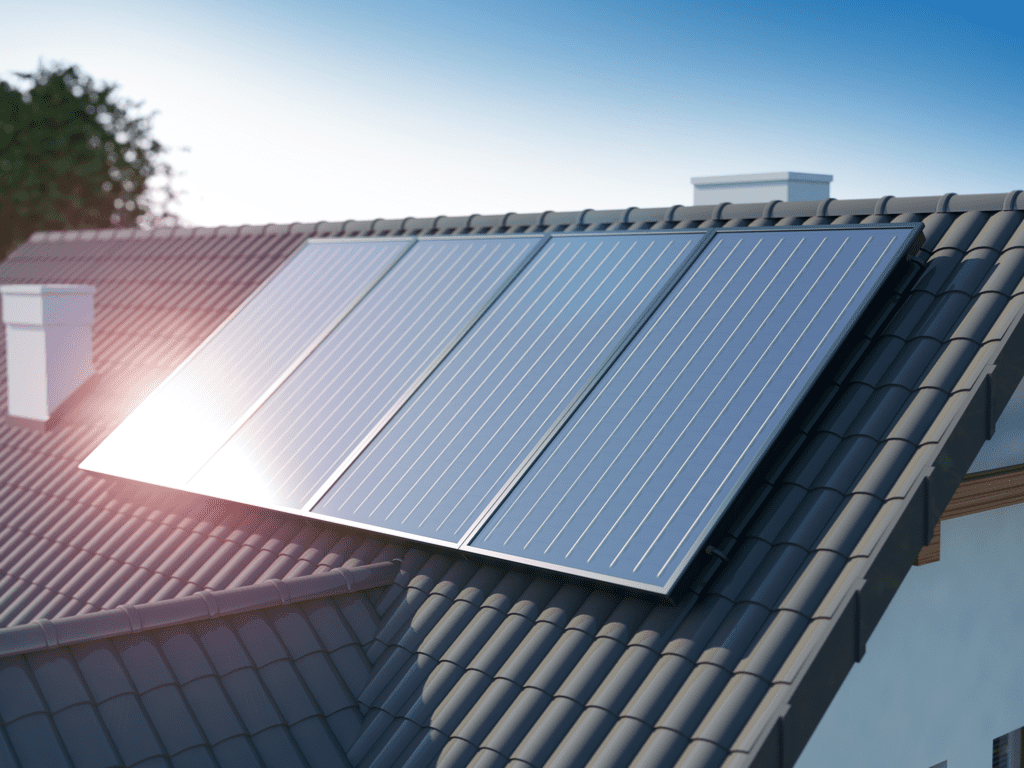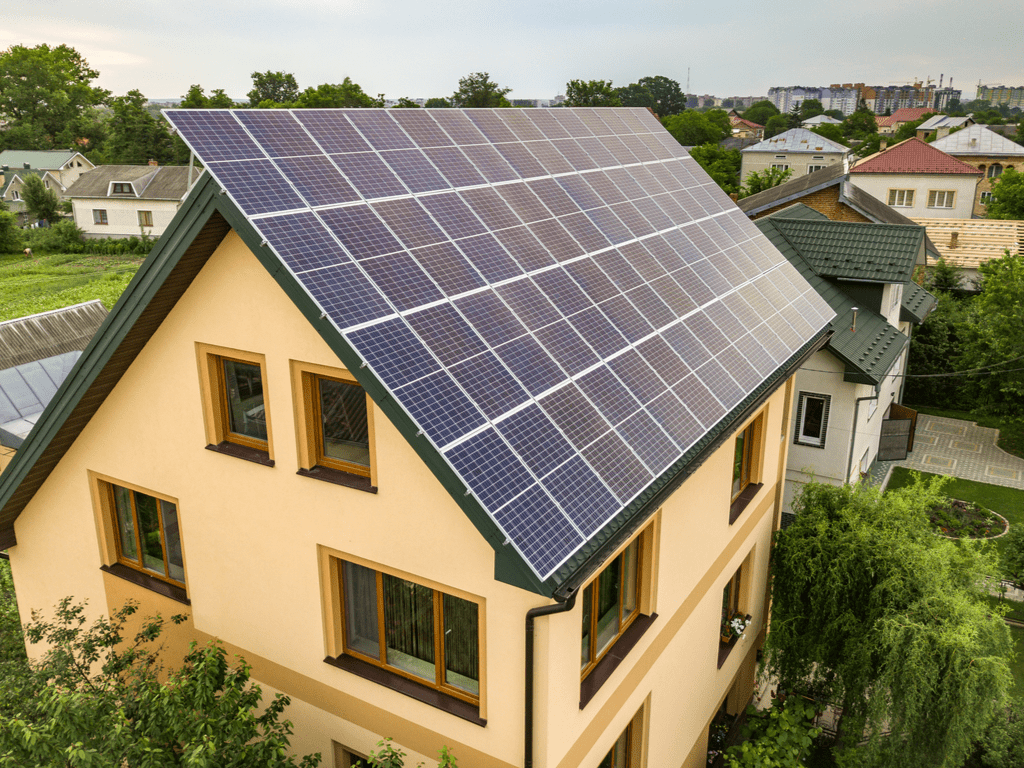Solar - FAQ
Creating Energy Independence
Find Out How Much You Would Save With Solar Now!
Thank you for your interest in solar energy! The information provided is designed to make you a more knowledgeable solar customer. If there is something else you would like to know, please reach out to us at [email protected]
Solar electric panels are made out of photovoltaic (PV) cells. These cells convert light energy from the sun to electricity. An inverter then converts the electricity generated by the panels from direct current (DC) to alternating current (AC), which can be used by the appliances in your home
Panels are attached to your roof using a racking system. There are a number of different racking system options depending on the roof type and roof condition. The best racking system for your home depends on how your roof is structured and what type of roofing materials you have. Your installer will recommend the type of racking system most appropriate for your property.
There are four factors that determine if solar will thrive on your roof:
Angle, Shading, Surface and Strength.
Ideally, you should have a south-facing roof. South-facing roofs maximize the amount of sunlight your panels collect. The more sunlight they collect, the quicker you can pay off your system with the electricity it generates. If your roof faces due east or west, it is still possible to go solar, but the panels will produce less energy (about 75% of what a south-facing roof would produce). If you have a flat roof, the panels can be installed to face due south no matter how your roof is oriented.
Once you’ve determined that your roof faces the right way, the next step is to ensure that your roof is not shaded. The portions of the roof where solar will be installed should be free of shade for most of the day, as shade can significantly reduce electricity production. Trees, chimneys, and dormers are factors that can cause shading on a roof. If you’re not sure if your roof is shaded, an installer can use a tool called a solar pathfinder to figure out if trees or other objects will cast shade during the day. Solar systems are most efficient when they are installed in a large interrupted space. Things like dormer windows, chimneys, vents, skylights, air conditioning units can be obstacles to installing a system.
In some cases, your roof may not be suitable for solar. This could be due to the obstructions on the roof (dormers, lots of peaks, chimneys, etc.), the roof’s integrity, shading, or other factors.
If your roof isn’t good for solar you may be able to install a ground-mounted system. You’ll need enough space far away from trees or other objects. Most ground mount systems are made out of a combination of aluminum and stainless steel and are mounted in concrete footings in the ground.
Many places, including Colorado and Minnesota (and soon D.C. and Maryland) allow what is known as community solar. This allows people unable to put solar on their roof to subscribe to receive energy from a solar installation somewhere else. Once they have done so, the electricity produced by their portion of the solar installation is credited to their monthly electric bill. Unfortunately, Florida does not yet allow for community solar.
Most residential solar electric systems don’t have batteries–yet. Systems without batteries are less expensive. They are also more efficient in converting the sun’s energy to electricity. Battery systems lose a small amount of electricity as the current moves through and stored in additional equipment. Batteries probably don’t make economic sense if you have stable utility electric service. They also take up room in your home, can require maintenance, and will likely need to be replaced at least once during the life of your solar system. If you do want to run some or all of your home when the utility electric service is down, you will need to include a battery bank and additional system components to your solar system to keep the batteries charged and ready for use when the power goes out. If you think you might want to get batteries in the future, tell your installer now.
Absolutely! This is an insulation map that compares the amount of sunshine received by the United States and Germany, respectively. Germany receives significantly less sunlight than the United States, but has nearly twice as much installed solar.
Solar panels generally have a lifespan of 30 years. Solar systems have no moving parts; the silicon cells are encased and protected by tempered glass with a sturdy, non-corroding aluminum frame. The inverters, devices that convert the DC electricity produced by your panels into the AC that is used by your home, have different lifespans depending on the type: Central inverters generally last for 10-15 years and will likely need replacement during your system’s lifespan. Micro-inverters generally last for at least 25 years and usually do not need replacement during your system’s lifespan. Will my system need maintenance? Solar systems have no moving parts, so you don’t need to do much to ensure your system functions properly. You don’t need to clean your panels regularly, since they are “washed” by rain.

Leaks caused by your solar system should be covered under your installer’s labor warranty. Give your installer a call and they’ll come out and fix it right away.
This will vary based upon where you live. Most localities require a permit to install and/or turn on your system. This is in place to ensure that your system is installed safely. You should work with your installer to ensure that your system is being installed up to local code.
This will vary based upon where you live. Most localities require a permit to install and/or turn on your system. This is in place to ensure that your system is installed safely. You should work with your installer to ensure that your system is being installed up to local code.
It typically takes 1-2 months for your installer to design your solar system and then secure initial permits and interconnection agreements. Once they have secured the proper permits, installers usually only need a day or two on-site to put up your system. They will then need to get final approval from the local government permitting office and secure final interconnection approval from the utility. This can take an additional 1-3 months depending on the jurisdiction.
When choosing an installer, you should consider their level of experience, competence, and the products they use. You will also want to weigh their ability to provide you the best service and support before, during and after your solar installation.
All installation crews should have at least one, if not all, of their installation staff be NABCEP or RISE certified. This includes their electricians. You should ask the installer how much experience they have with installing systems that are similar to yours.
You will also want to ask your installer what components they offer and typically install. This is helpful if
there is a specific type of component package or offering (e.g., American-made, high-efficiency, ground mount) you value.
You should also research prospective installers by asking for references and looking at review sites such as Angie’s List.
What can I do if my homeowners association says it won’t allow solar?
If you are encountering resistance from your HOA, join the FL SUN listserv and let us know. We can help you navigate the process. Often, if you get a number of residents from the same HOA together to go solar, you can overcome restrictive HOA rules.
Solar installations in historic districts typically must go through an additional step in the permitting process to ensure the location and method of installation comply with local historic requirements. In some jurisdictions, this review is done within the standard permit review process. In others, it is handled by a separate historic review board. Your installer will be familiar with the requirements in your area. You should expect your installer to work with the relevant review body to secure the necessary permits. The cost for doing so should be included in the cost of going solar.
This answer will vary depending upon the size and type of system you purchase. A typical medium-sized system costs roughly $11,000. Please note, this figure does not include the 30% federal tax credit.
Payback time depends upon several factors: size of system purchased, average energy usage, the price of electricity, and value of renewable energy credits. We advise solar customers to estimate a 9-20 year payback time.
- What is the term of the loan?
- What is the interest rate, and is it fixed for the entire term of the loan?
- Are there penalties for pre-payment? (If pre-payments are allowed you can use the additional savings from your energy costs, your federal tax credit and your SREC payments to pay down the loan more quickly.)
- Is the loan secured against my property or unsecured?
- Will the combination of my loan payments and my remaining utility bill be higher, the same or lower than what I pay right now for electricity before solar?
For a detailed guide to solar Financing check out this homeowner’s guide from the Clean Energy States Alliance.
Net metering- Net metering allows you to offset your energy consumption with your energy production. When your solar panel is producing electricity your electric meter runs backwards. When you’re using more power than your system generates, your electric meter runs forward. At the end of the month, your final electric bill is your total usage minus the electricity that your solar panels produced.
If at the end of the month you have generated more electricity with your solar panels than you have used, you can roll over this credit on your bill to the next month, just like ‘rollover minutes’ for your cell phone. With net metering, you get full credit for periods of excess solar production and are only billed for the total electricity you purchase from your utility over the course of the year.
Federal Tax Credit- This tax credit provides you 30% off the total cost of the system. This is calculated before other incentives. You still have to pay up front for the system, but when you file your taxes you will receive a 30% credit (not a deduction) from the federal government.
Learn more about the 30% federal tax credit.
Solar Renewable Energy Credits (SRECs)- When you generate solar electricity from your system you also generate an associated “green value” for your electricity. This is known as an SREC. Every time your system produces 1,000 kWh of electricity, you get one SREC. These SRECs have a variable monetary value, like a company’s stock or commodity product.
“Price per watt” is how installers price solar systems. As the name implies, this is the price you will pay for each watt of electricity your system is rated to produce. Each solar panel comes with a wattage rating. This rating is the amount of DC (direct current) power the panel produces under test conditions. So, a panel rated at 300 watts produces that much power output.
A solar system made up of ten 300 watt panels would produce 3,000 watts*. Let’s assume that system costs $10,000. Doing the math, the cost per watt of the system is $3.33.
$10,000/3,000 watts=$3.33/watt
If you find there are issues with your system you should contact your installer and work with them to get the issue resolved. You should have an online monitoring portal available to you. This will show you the amount of energy you generate. You can use this information to verify if your system is still producing energy in the quantity it did before. Keep in mind that energy production fluctuates from day to day, month to month, and year to year based on weather conditions and other factors. Despite those fluctuations, you should see a consistent curve of energy production over time.
It is common for systems to produce more than a home uses during the day when you are not home, using electricity. Net metering is a billing system that ensures you receive fair compensation for the electricity your system generates. It allows residential solar energy generators to offset energy consumption with energy production. When your solar panels are producing more electricity than you’re using on site, your electric meter runs backwards. When you’re using more electricity than you system is generating, your electric meter runs forward. At the end of the month, your final electric utility bill is your total usage minus the electricity that your solar panels produced.
There are three kinds of warranties relevant to your solar system: product warranties, production warranties, and installation warranties. Product warranties guarantee the physical integrity of the modules and other system components. For example, if one of your modules has a soldered connection fail, causing it to stop producing energy, it would be replaced under the product warranty. Most solar modules have a 10-year product warranty. Some high-end modules feature product warranties of 25 years or more. Inverters, devices that convert the DC electricity produced by your panels into AC that is used by your home, have product warranties from 10 to 25 years. String inverters may need to be replaced after 10 to 15 years. Some manufacturers offer the option of purchasing extended warranties for your inverters.
The energy production warranty generally guarantees that a functioning module will produce at least 80% of its originally rated capacity for 25 years. While the details vary from manufacturer to manufacturer, this type of warranty provides assurance that your system will continue to produce power over its lifetime. In practice, identifying whether your system is experiencing a drop in performance that violates this warranty is difficult without the troubleshooting help of an installer. Despite that, production warranties are still a proxy for the expected performance degradation for your solar modules over time. Most solar modules have a 25-year energy production warranty. Some high-end modules feature warranties of 30 years. Installation warranties cover the workmanship of the installer and includes such things as the roof penetrations they make to attach your system to the building and the electrical wiring work. The length of installation warranties will vary from installer to installer but generally range from three to 10 years. Some installers will offer warranties as long as 20 years.
Most solar manufactures now offer 10-year product warranties and 25-year power production warranties. These protect you from system failures and guarantee your solar systems will produce 80% of their rated capacity after 25 years. But what happens when your panel manufacturer goes out of business? Unfortunately, unless you take extra steps, your warranty will likely no longer be valid. This is because warranties are considered an unsecured liability under the law. However, there are a few things you can do to prevent a loss of warranty protection should your panel manufacturer go out of business: Buy an extended warranty: If the manufacturer goes bankrupt, extended warranties offered through the solar panel retailer are a contractual agreement between the retailer and the consumer, which makes them legally valid. However, you are still out of luck if your manufacturer and your retailer both go out of business. Buy from a warranty-insuring manufacturer: Probably the best way to protect yourself from a manufacturer going out of business is to buy panels from a manufacturer who provides third-party insurance for your panels. If the company ever goes out of business the insurance ensures that their warranties will still be honored by the insurer.
When you install a solar system, you’re still connected to the electric grid. When the sun is shining, your panels generate electricity that is used in your home. At night or when the sun isn’t shining, you get your electricity from the electric grid (just like you do now). The process is seamless and happens automatically. You will always have power to your home.
You will need a building permit to install solar on your home. Your system’s design must meet electrical and building code requirements. Local building codes require that solar panel installations are securely fastened to your roof and can withstand wind uplift. This is done to ensure your system stays on your roof during a storm. Code requirements will vary depending upon where you are in the state, as some localities have higher requirements than others. However, all solar systems in Florida must be designed to withstand hurricane-force winds. Before a solar company can install a system on your home they must have the system design reviewed and approved by the Florida Solar Energy Center (FSEC). Your solar installer will take care of submitting all engineering designs and paperwork to FSEC. Once you’ve installed your system, make sure to contact your homeowner’s insurance provider and let them know you’ve added solar to your roof. This will ensure that your policy covers your system as part of your home and will be eligible for replacement should your home be damaged in a storm or hurricane.
If the grid goes down and you have a grid-tied system, you will lose power as well. This is a safety precaution for utility workers, since solar can send excess energy out on neighboring wires even if the local distribution system itself is not functioning. Some brands of inverter offer a backup power supply of 1,500 watts during a power failure and when the sun is shining. This would be enough to power small electronic devices or lighting via an electrical outlet connected to the inverter itself. You can also opt to pair your system with battery back up. Should the grid go down, you can power part or all of your home with the energy stored in your battery.
A report by the National Renewable Energy Laboratory found that most rooftop solar systems should be covered as part of your standard homeowners policy. Contact your insurance company before you install your system to let them know about the addition to your property. You should be sure to verify that solar system replacement costs in the event of damage don’t exceed your current policy coverage limits. Adding solar should not increase your homeowner’s insurance premiums. If it does, you may want to find an insurer that provides discounts to customers that “go green”. The report does note that ground-based solar systems may not be covered and may require additional insurance.
The answer depends upon your system’s ownership structure. The appraisal industry is training its workforce to accommodate the growth of solar nationwide. The Appraisal Institute now offers training for real estate appraisers on how to appropriately assess the value of solar and other energy efficiency measures add to a home. Make sure to request a real estate professional properly trained in evaluating the impact of solar when the time comes for your home to be appraised. If you own the system, it will convey with the home and can help improve its resale value. A study by Lawrence Berkeley National Laboratory found that on average, a typically sized residential solar system adds $15,000 to the resale value of a home.
The study included an analysis of more than 22,000 home sales across eight states – nearly 4,000 of which contained PV systems. The home sale data used spanned 2002 to 2013. If you lease the system, you may have a few options depending upon your lease agreement. It may be possible to transfer your lease as part of the home sale. Or, you may have to pay off your lease before selling your home. You can then include the cost of this pay off in your home selling price. If you are a licensed real estate appraiser and would like to learn more about including the value of solar in your appraisals to remain at the cutting edge of your field, click here.
A solar system should last roughly 30 years. It’s important the roof underneath be in good shape. If your roof is more than 10 years old, we recommend having it evaluated to determine its remaining lifespan. You may want to consider repairs or replacement prior to installing solar. If you need work done to your roof after you install solar, you can pay a qualified installer to remove the system before the roof work and re-install it afterward. Costs for this vary, but typically range between $1,000 and $2,500.
Most people don’t have enough space on their roof to offset 100% of their electricity needs. You can still offset a portion of your electricity bill with solar. A solar system on a typical house will produce about 30-60% of your electric needs (assuming an average consumption of 850kwh/month). But that percentage depends on how much electricity you use.
Your installer will estimate how much solar will fit on your roof. They will also estimate the amount of electricity your system will produce each year. These projections are very accurate, based on several decades of testing by the U.S. Department of Energy.
You can use the website, PV Watts, to estimate how much solar you could put on your roof. Then, you can compare the system’s estimated annual electricity production to the amount of electricity you used last year. This will tell you what percentage of your electric bill you could offset with solar. Click here for a tutorial of PV Watts.


